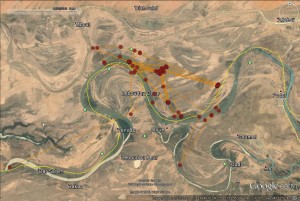Osprey Update 26th November
Still no news of Blue YZ which sadly means we are unlikely to make contact with her again- it does look most likely we’ve tragically lost her in Guinea Bissau.
Lots of people have asked about why she might have perished and of course, there are many possibilities. One is that by spending so much time resting and stocking up on route in Spain (which may have helped her survive the Sahara crossing) she may have arrived late in west Africa and found it difficult to establish a territory. It is possible that all the best spots were already taken , especially by more dominant adult birds, and she may have struggled to find enough to eat and a space to settle with all the competition.
Meanwhile, our other young osprey Blue YD is still doing well and has spent the last week in his usual favourite spot on the Senegal river. We’ve lost track of how many times he’s criss-crossed the border with Mauritania as it straddles the river where he ranges.

Q: What satellite system are you using to track your birds? Who manufactured your transmitters?
A: We are currently using tags manufactured by Microwave Telemetry Inc from the USA, and the data is hosted by a French satellite company.
Q: Is the SWT planning on monitoring more birds next spring?
A: Yes we plan to tag at least one more young osprey next year as part of our long term commitment to research and conservation of this species.
Q: Are there any other researchers who are tracking birds from other countries?
A: Yes, there are at least four osprey sites in the UK undertaking satellite tracking this year alone ( RSPB Loch Garten, Rutland Osprey Project, Highland Foundation for Wildlife and Lake District Osprey Project) and various others in Europe and North America. This technology is also now widely used with many avian species, as small as cuckoo’s ( BTO) .
Q: What was the verdict on the eggs which failed to hatch this year? Were they fertile? If so, could the failure to hatch have been due to the male’s lax attitude to incubating?
A: We had the eggs analysed by the National Museum of Scotland and the verdict was that two were unfertilised, and in the third the embryo lasted only a few days. Therefore it seems to be a fertility issue, not the male’s fault at all. For more details here is the link to a more in depth blog post: http://blogs.scottishwildlifetrust.org.uk/osprey/2013/07/19/osprey-diary-friday-19th-july/
Q: If an osprey turned up in the UK with a tag that was no longer working is it possible to somehow trap the bird in order to remove the tag?
A: It is difficult to catch adult ospreys and the risk of injury from the process would be higher that the risk posed to the bird by leaving the old tag on. All the tags have a built in ‘failsafe’ whereby the harness comes apart, as a condition of the government license to do this research.
Q: Why don’t you actually give the birds names?
A: We have a charity wide policy of not naming wildlife, though we do understand the reason that others may choose to do so. We have received many opinions from our members and viewers in support of and against using names, both passionately argued. There is also the complication that with a bird that has been around for as long as our female, there are many names by which she is known by various groups and forums – each with their own favourite. We decided the only way to please everyone is to avoid, where possible, using any name, and refer to her as ” our resident female” and so on. We decided to keep things simple and only use birds Darvic ring numbers, to try to strike a balance and keep things simple.
Ranger Emma
Help protect Scotland’s wildlife
Our work to save Scotland’s wildlife is made possible thanks to the generosity of our members and supporters.
Join today from just £3 a month to help protect the species you love.
Preface
Still no news of Blue YZ which sadly means we are unlikely to make contact with her again- it does look most likely we’ve tragically lost her in Guinea Bissau. …
